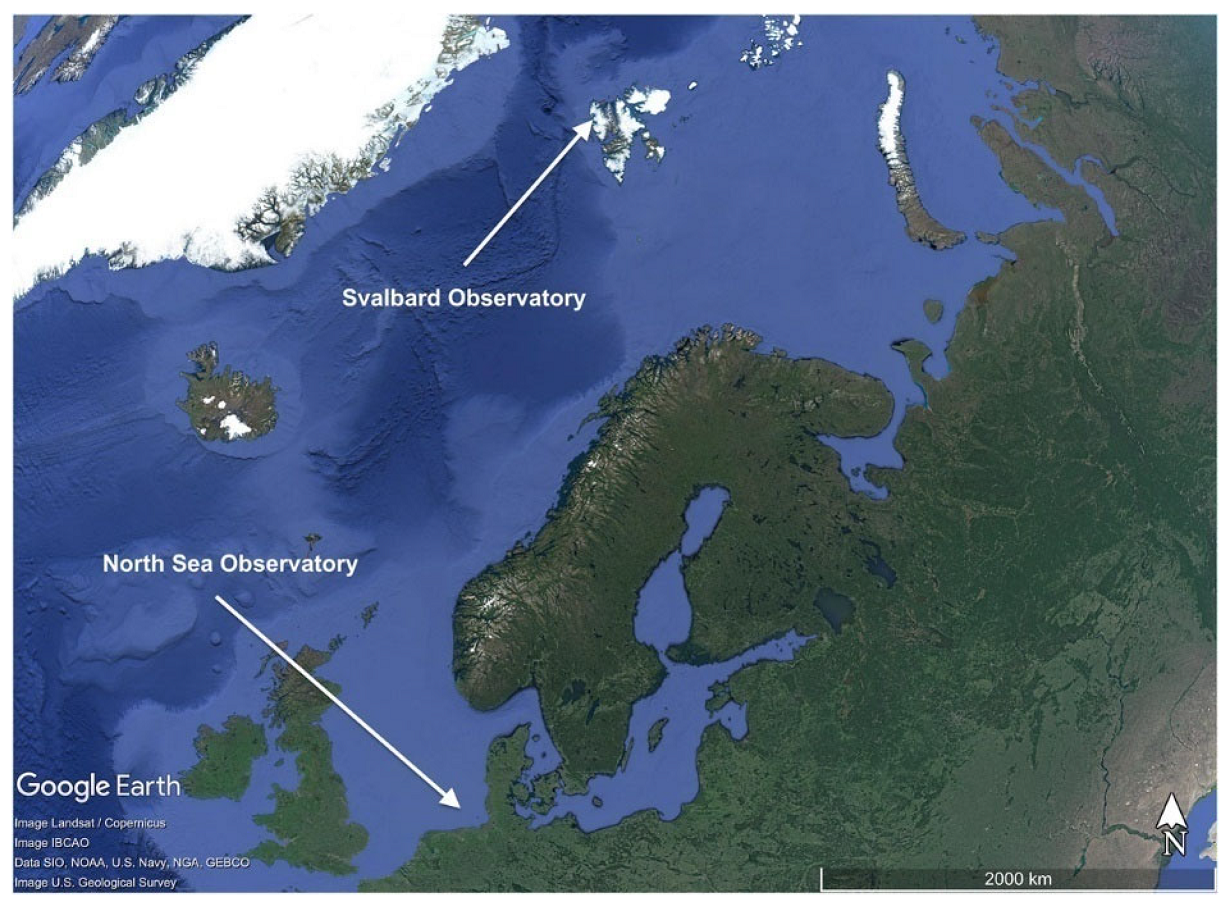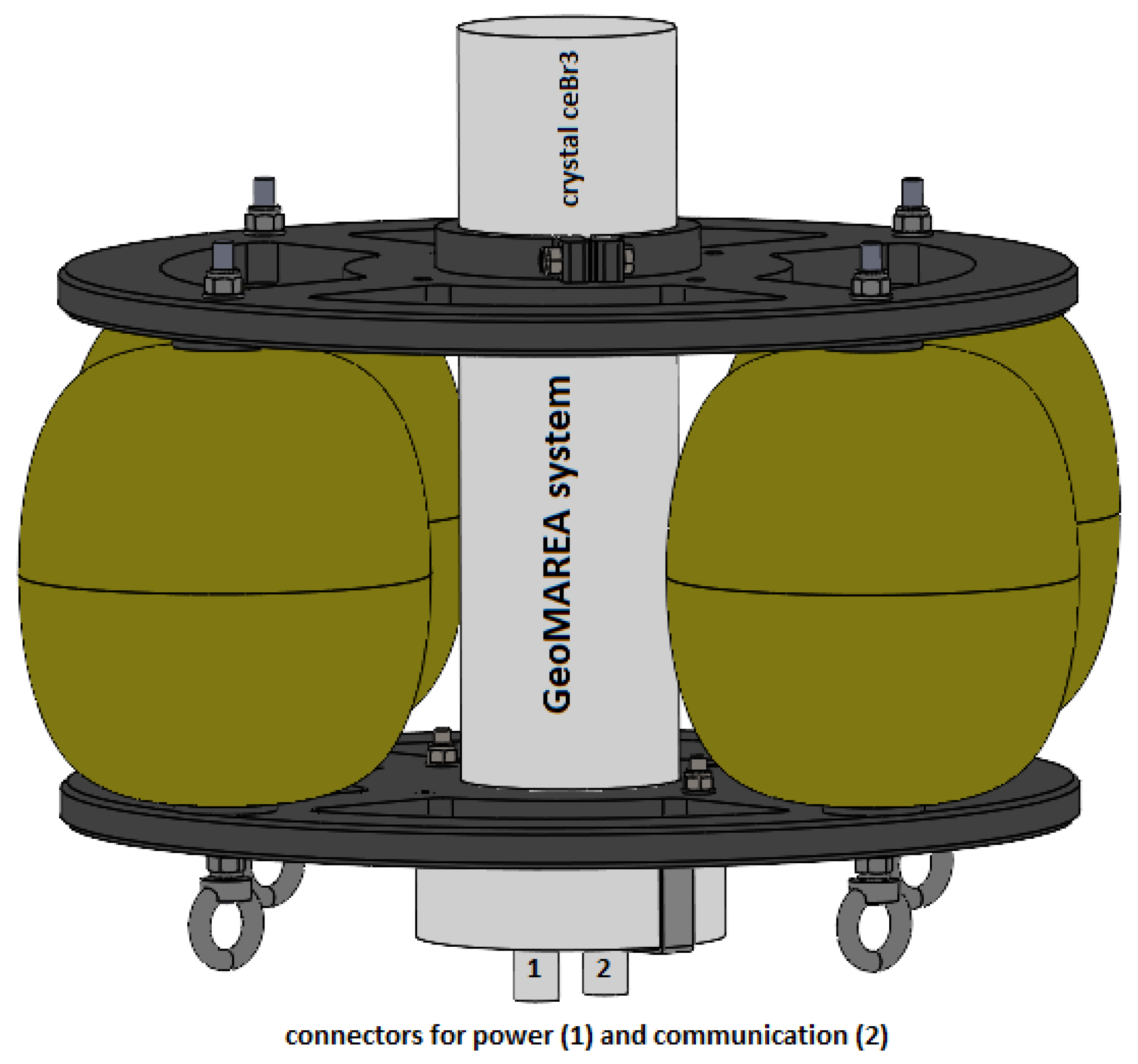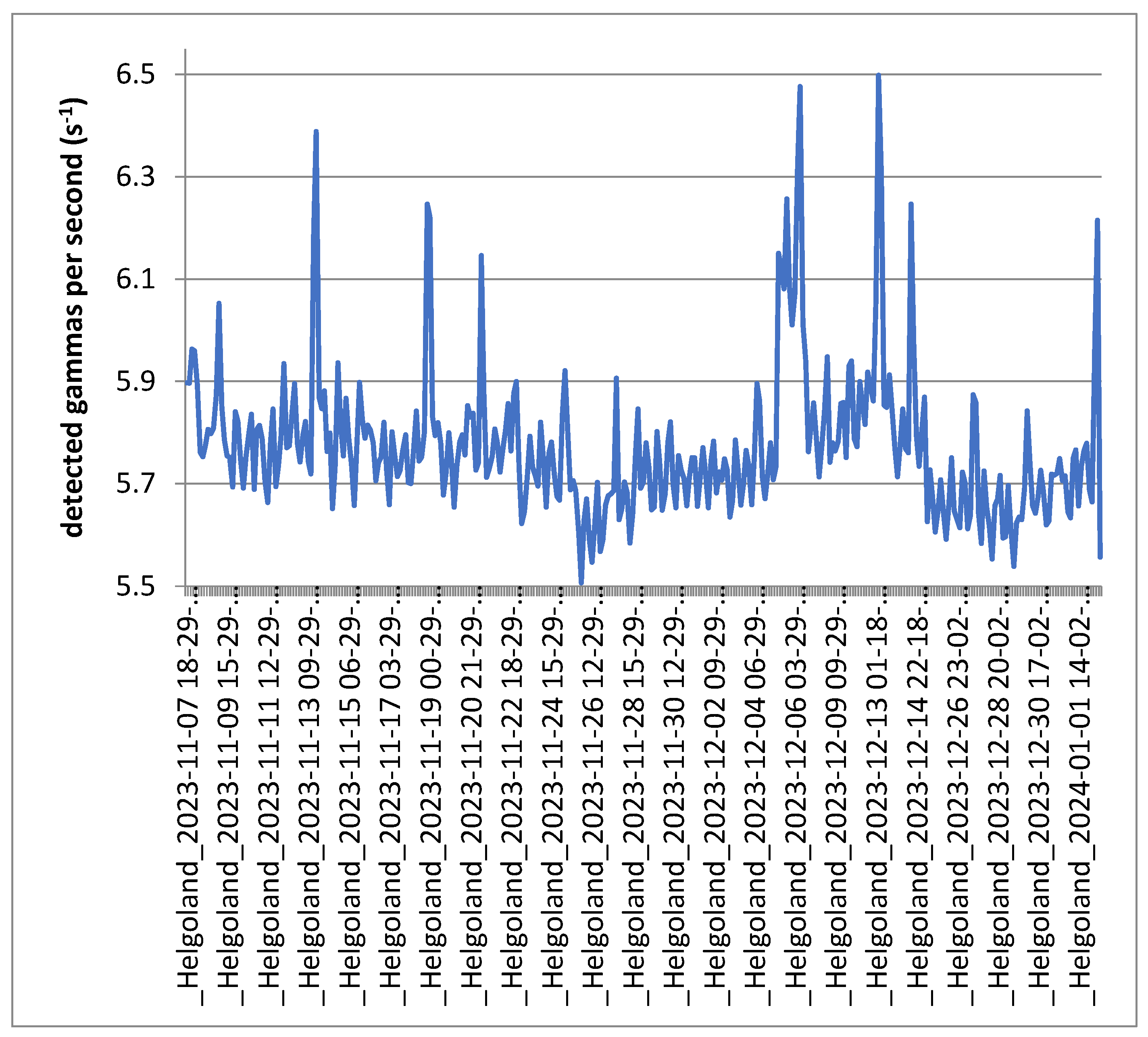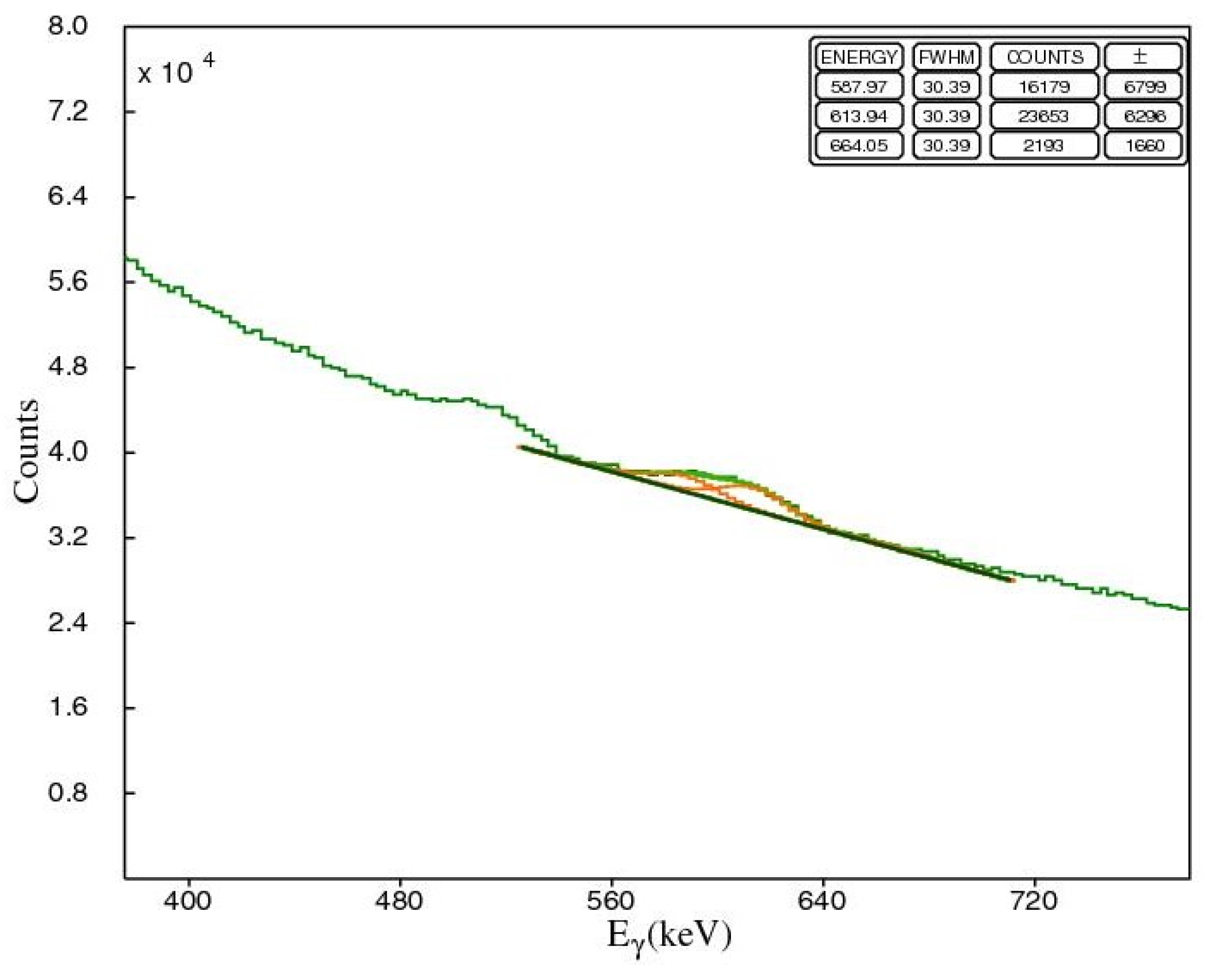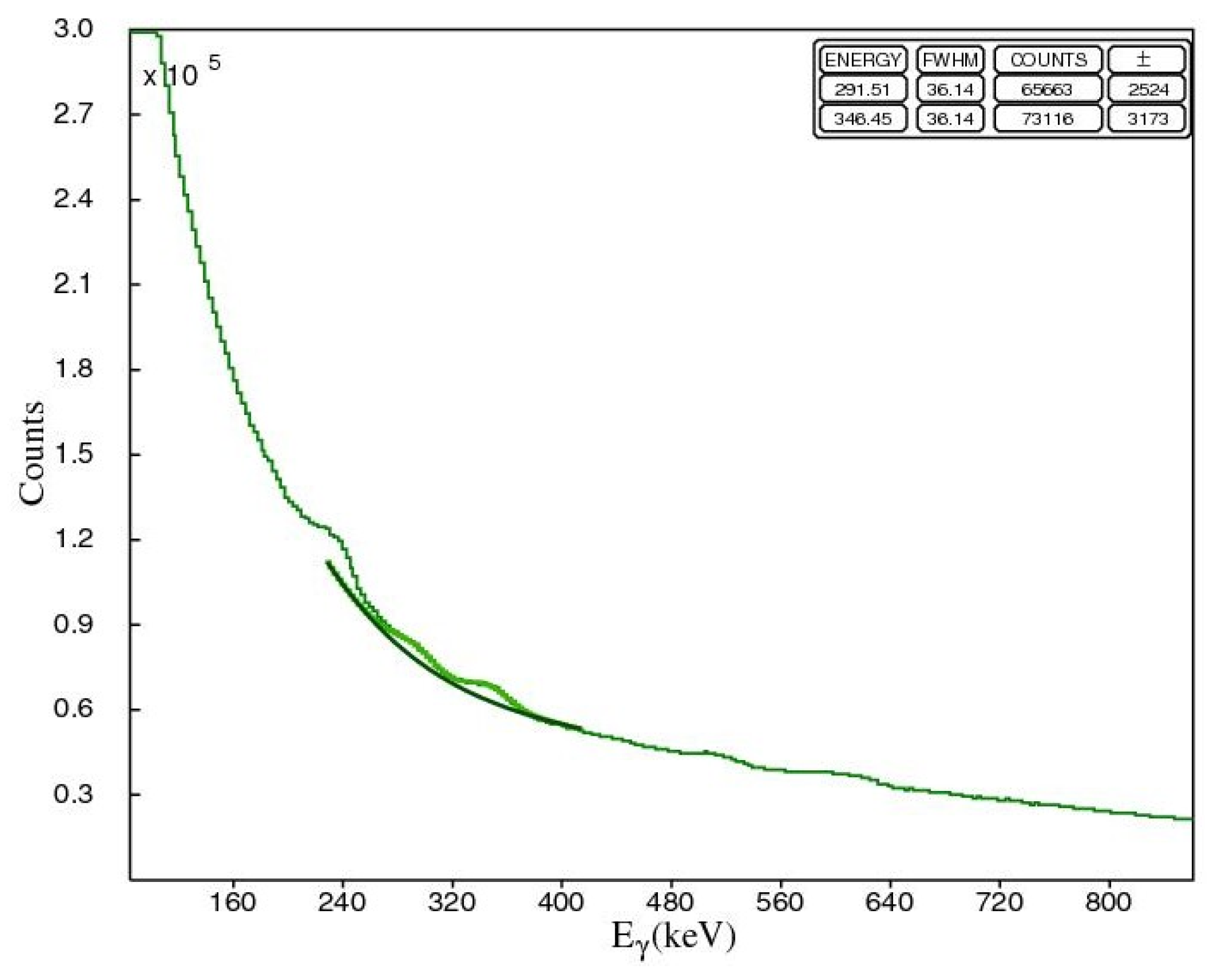1. Introduction
The detection of hazardous materials and related monitoring systems have attracted great technological and scientific interest in recent decades for the identification of contaminants in oceans using direct and lab-based methods. Direct methods rapidly identify the state of the studied marine area, but the available detectors are limited for underwater operations and cannot be integrated in existing platforms. Notably, past and recent review information related to in situ applications in the ocean is presented in detail in the literature [
1,
2,
3,
4].
The identification and monitoring of ionizing radiation (alpha particles, beta particles, gamma rays and X-rays) and neutrons in the marine environment through detection systems exhibit many difficulties due to ocean conditions, as well as due to the absorption of radiation in the water. In recent years, a lot of effort has been made to monitor gamma-ray intensity in seawater, enabling smart systems and methods. Very briefly, the continuous monitoring of radioactivity in the ocean is performed by integrating underwater in situ sensors in fixed stations, such as buoys and landers [
5,
6], as well as in mobile units [
7,
8].
In recent years, a lot of effort has been made to understand the distribution of and changes in oceanic rainfall patterns as a major component of the global/regional water cycle and climate change. The most commonly implemented instruments to measure rainfall are rain gauges, together with other in situ underwater sensors (such as gamma-ray spectrometers to measure the activity concentration of radionuclides). As established by radioactivity measurements in the sea, radon progenies are observed after and during rainfall events [
4,
9]. Radon (
222Rn with a half-life of 3.825 d) is a noble gas and is found in aerosol particles in accumulation mode. Radon progenies are transported from the atmosphere to the sea surface by the scavenging process of rainfall, and can be observed after rainfall via their short-lived radon daughters (
214Bi and
214Pb). The activity concentration of radon progenies (gamma-ray emitters) in seawater or sediments can be detected via
214Bi and
214Pb, by deploying underwater gamma-ray spectrometers in the corresponding matrices. The observed radon concentrations vary with respect to rainfall intensity, rainfall type and humidity.
As concerns artificial radioactivity fallout in the oceans, the crucial radionuclide for continuous monitoring is
137Cs, since it is present as a nuclear fission product, is highly enriched in seawater, has a long half-life, and is monoenergetic and easily detected with gamma-ray spectrometry. All national laboratories provide routine and emergency monitoring of Cs as a key tracer of nuclear incidents. For instance, in European seas, many experimental and model data of
137Cs have been reported to control potential gradients of activity concentration. This helps to better define background concentrations and understand the temporal and spatial evolution of anthropogenic radionuclides in order to protect humans [
10,
11,
12,
13,
14,
15].
The collection of continuous radioactivity data in the marine environment demands large infrastructures (such as fixed and mobile monitoring stations (research vessels) in the ocean). Moreover, the surveillance of radioactivity levels in the marine environment is needed to protect humans in case of nuclear incidents (such as nuclear accidents/nuclear blasts). The aim of this work is to exploit existing infrastructure (the cabled network and underwater gamma-ray spectrometers) in order to provide a time series of marine radioactivity in a cost-effective manner. In this work, a new medium-resolution underwater spectrometer (named GeoMAREA [
16]) was tested for its capacity to provide time-series data on a continuous basis via its integration into the Helgoland Underwater Observatory (HUWO), which was founded in the framework of the COSYNA project [
17,
18]. The specific location was selected to provide baseline information on a continuous basis for the radioactivity levels in the sea, as well as to expand the existing monitoring infrastructures in other areas of the world for an effective monitoring of radioactivity in the sea.
The deployment of the detection system and its integration in the cabled observatory network in the North Sea lasted from 7 November 2023 to 8 January 2024. The proposed technology is effective, autonomous, and robust, with low power consumption. This cost-effective in situ radioactivity system enables real-time measurements of gamma-ray intensity for each gamma-ray emitter present in the seawater. The data analysis provides baseline information regarding potential contaminants originating from anthropogenic activities or natural processes. Furthermore, the method has proven reliable to be utilized for decision-making in the case of incidents related to variations in the radioactivity levels produced by gamma-ray emitters. This complementary information will dramatically support existing actions for assessing the state of the sea in the future, and will help national authorities and policymakers to protect humans against potential nuclear incidents.
3. Sensor Upgrade and Integration
The GeoMAREA detection system was implemented to provide continuous activity concentration data of gamma-ray emitters enriched in the marine environment in near-real-time mode. The GeoMAREA system is an underwater medium-resolution spectrometer that uses a 2″ × 2″ CeBr
3 detection crystal connected to a photomultiplier tube, a preamplifier, and a power supply unit. It uses electronics for signal amplification, data acquisition and data storage. The details and application of the system are described elsewhere [
16]. The enclosure was designed to offer continuous functionality up to 600 m water depth. The system is designed to be integrated in any stationary platform and cabled network, enabling it to operate in (near) real-time mode. The data logger of the system was programmed accordingly to communicate with any typical computer system via a hyper-terminal RS232 interface, and then to operate in a sequential buffering mode to save the data. A specific software code is developed for this function, allowing the end-user to give as an input the time lag of the time-series acquisition before the communication is initialized. The underwater detection system GeoMAREA was calibrated (for energy, energy resolution and efficiency) and tested for its stability against temperature variations before the deployment. The data logger of the system was appropriately programmed to easily perform all necessary acquisition commands (such as start, set preset time, set spectroscopy and set threshold channels) by remote command via the network. The system was sending data in near-real-time mode every 3 h, providing information related to the activity concentration of gamma-ray emitters in the sea. The system was connected to a virtual machine in the host institute. The operational centre at HCMR had full access via the internet to this virtual machine and the data at all times.
The experimental set-up for the integration of the GeoMAREA system in the HUWO is shown in
Figure 2. The GeoMAREA system was deployed at a distance of around 2 m below the sea surface and 9 m from the seabed (see
Figure 3). This set-up was selected to avoid the contribution of gamma rays produced in the atmosphere, as well as sediment from the seabed. The volume of the construction in combination with the material was taken into account for the quantification method. The crystal stuck out from the frame (more than 10 cm of the crystal of the GeoMAREA system was exposed to the sea, well below the sea surface).
The end-user (HCMR) could continuously check the system operation and the quality of the measured spectra, as well as the whole process and state of operation. In case some dysfunctions were present, the end-user informed the host institute about the problem and the necessary steps were performed by the latter. For the deployment, recovery and maintenance of the system, scientific diving according to DGUV Regel 101-023 was used [
20]. The time lag of the system was set to 3 h.
4. Results
The gamma-ray spectra were analysed with the SPECTRW [
21] software package (version 8). Our first comment on this analysis procedure is that the use of a medium-resolution crystal compared to low-resolution scintillators makes the analysis easier for those radionuclides that emit gamma rays in neighbouring energy intervals. The sum of all spectra provided a good statistical spectrum for the analysis, including the identification of low-activity-concentration radionuclides in the low-energy part of the spectrum.
The first step of our analysis method was to calculate/monitor the total counting rate of the system during the acquisition period. In
Figure 4, we depict the time series of the values of the total counting rate, as observed by the GeoMAREA detection system (which is, in fact, the gamma-ray intensity rate or the total counting rate (TCR)). The TCR is a key factor to assess any potential gradients of marine areas that are under surveillance in terms of naturally occurring or anthropogenic processes/phenomena. There are two main types of phenomena when there are changes in TCR gradient. The first is related to the natural gradient of radon progenies due to rainfall, and the second one has anthropogenic origin and may be due to a nuclear incident (e.g., an identification of a radioactive plume due to a nuclear accident or nuclear blast). The key anthropogenic tracer that can be easily detected after a nuclear accident or nuclear blast is cesium, due to its high production fission yield. It can be detected via gamma-ray spectrometry from its two isotopes (
134,137Cs). Another critical chemical property of cesium is that it is highly soluble in seawater. The second step of our method is the analysis of the total gamma-ray spectra as acquired during the period of the experiment, as well as the selection of gamma-ray spectra acquired in key periods of time according to their counting rate gradients.
In
Figure 4, the total counting rate is depicted along with the time of acquisition and the time lag (3 h) of the detection system. On the
x-axis, detailed information (such as file name) is included, indicating the time stamp of each spectrum acquired. The observed spectra were analysed appropriately to calculate the TCR. The results exhibit several gradients, which were mainly caused by rainfalls that took place at specific periods of time. The background counting rate was about 5.7 counts/gamma rays per second.
The second step is focused on the analysis of the observed photopeaks, starting from the high-energetic part of the spectrum (which is a low-background spectrum area affected mainly by the Compton continuum of cosmic rays). The total gamma-ray spectrum acquired during the acquisition period is depicted in
Figure 5. As concerns the uncertainty budget, all uncertainties were calculated using the propagating law of uncertainties, considering mainly the statistical uncertainty of the measured photopeak net counts and the uncertainty of the efficiency of the detection system. The reported values correspond to 1 s of uncertainty.
The first peak that was analysed was at 2614 keV of
208Tl and the second was at 1461 keV of
40K. These photopeaks are intense (well separated from other contributions) on the spectrum. The analysis provided average activity concentrations of 40 ± 5 and 9880 ± 590 Bqm
−3 for
208Tl and
40K, respectively. The contribution of the CeBr
3 crystal intrinsic radiation and the gamma rays of
214Bi at the energy window at 1461 keV was calculated and subtracted according to the literature [
16]. The intrinsic radiation of the CeBr
3 crystal was also detected between 600 and 800 channels, making the analysis method insufficient to analyse peaks of
214Bi at around 1764 and 2200 keV.
The following peaks that were analysed were those of 228Ac at 911 and 968 keV. In these photopeaks, the contribution of 214Bi (gamma rays are emitted at 934 and 964 keV) was subtracted accordingly from the 609 keV net count (which is described in the following text). The average activity concentration of 228Ac was calculated from the two aforementioned photopeaks of 52 ± 13 and 62 ± 17 Bqm−3, respectively. It should also be mentioned that the strong peaks at the energy window of 1600 to 2200 keV are produced due to the intrinsic radiation of the crystal.
The next step was the analysis of the radionuclides
214Pb,
214Bi,
208Tl and
137Cs at 291, 351, 583, 609 and 661 keV, respectively. In this step, some peaks were folded due to the energy resolution of the system, and thus a special process had to be considered to unfold these peaks. The unfolding analysis was performed using the SPECTRW software package V8 [
21], and the individual contribution and the results of each photopeak count for the radionuclides
214Bi,
208Tl and
137Cs are given in
Figure 6, while the results of the radionuclide
214Pb for two energy lines are depicted in
Figure 7. It is significant to mention here that the counts depicted in
Figure 6 and
Figure 7 include counts of gamma rays from other natural radionuclides (for instance, at the 251 energy window of
214Pb, there is a negligible contribution from
228Ac). The final activity concentration is calculated by subtracting the counting rate of this contribution, considering the quantification method. In the case of triple energy lines unfolding, the statistical uncertainty of the detected counts becomes high due to the minimum detectable activity of the GeoMAREA detection system. The average activity concentrations of
214Bi,
208Tl and
137Cs are 108 ± 32, 105 ± 54 and 6 ± 4 Bqm
−3, respectively.
The
137Cs energy peak is not clearly seen on the graph in
Figure 6. However, the results of the analysed net photopeak counts are automatically given from SPECTRW [
20] together with the energy lines, the energy resolution in absolute units, and the uncertainties of the analysed net counts. The FWHM at 661 keV is around 30 keV, which is similar to the FWHM at the same energy (~28 keV) when the system is calibrated in the tank [
16] by diluting
137Cs calibration sources in drinking water in the tank. The minimum detectable activity of the GeoMAREA detection system provides uncertain results for
137Cs (at 661 keV) and
208Tl (at 583 keV) in terms of statistics.
A similar process was followed for the analysis of
214Pb at 291 and 351 keV (see
Figure 7). The unfolding analysis using the SPECTRW software package [
21] provided the net count contributions of all the participating natural radionuclides in the measurement. For instance, at the gamma-ray energy window of 351 keV, there are two other energy lines of
228Ac at 338 and 328 keV, while at the 291 keV gamma-ray energy window, there is a contribution from a low-intensity energy peak of
212Pb at 300 keV. The quantification method provides results for the two emission energies of
214Pb’s average activity measurements during the acquisition period, which are 126 ± 14 and 147 ± 16 Bqm
−3, respectively (which agree within uncertainties).
The
214Pb energy peak is not well distinguished on the spectrum in
Figure 7. However, the unfolded results of the analysed net photopeak counts are automatically given from SPECTRW [
20] together with the energy lines, the energy resolution for each peak in absolute units, and the uncertainties of the analysed net counts. The FWHM at 291 and at 351 keV is around 36 keV, which increased by 35% compared with the FWHM at the same energy (~22 keV) when the system was calibrated in the laboratory [
16] using point sources. This increase may be attributed to the aforementioned gamma rays from other neighbouring (in terms of gamma-ray energy) radionuclides (
228Ac at 338 and 328 keV affects the 351 keV energy peak, and
212Pb at 300 keV affects the 291 keV energy peak).
5. Discussion
In this work, a medium-resolution detection system named GeoMAREA was tested as part of the Helgoland Underwater Observatory (HUWO) at Helgoland Island (Germany). The time lag of the system was set at 3 h to observe the short-term potential gradients of the radioactivity levels of natural and/or anthropogenic hazards. The gradients of the total counting rate of the detection system exhibited variations only due to the rainfall events that took place during the period of acquisition. More specifically, radon progenies (214Pb and 214Bi) were the main contributors to the variation in total counting rate, since rainfall enriches radon progenies in seawater.
The activity concentration of radioactivity in the area of study is correlated with the rainfall data of the same period, since rainfall is the main air–sea interaction process that can bring radionuclide concentrations from distant areas through atmospheric mechanisms [
22]. The correlation of the gamma-ray intensity detected by an underwater detector in seawater with rainfall parameters is of high importance to better understand the origin of the type of radioactivity and its transfer mechanism (for instance, if the specific radionuclide is detected via an atmospheric fallout or if it is transferred from ocean processes). For this purpose, radioactivity data were compared with quantitative rainfall data in units of lm
−2 considering the period of monitored activity. Due to statistical issues, underwater measurements of the gamma-ray emitters (such as
40K and radon progenies) were not taken daily. The rainfall data were taken from an existing database [
23] and are plotted in
Figure 8.
The rainfall data are correlated with the gamma-ray intensity of the measured gamma-ray spectra, as plotted in
Figure 4. The rainfall height was not linearly correlated with gamma-ray intensity, validating previous studies where a non-linear relation of rainfall intensity was revealed with the activity concentration of radon progenies [
4,
9]. The above correlation is qualitative and only takes into account the daily average rainwater height and not the rainwater intensity.
The dates of rainfall coincide well with the enhancement of gamma-ray intensity. More specifically, from 11 to 14 November 2023 (11-14/11/23), the rainfall height is around 32 lm−2, while the gamma-ray intensity recorded by the GeoMAREA system is 6.3 s−1. Similarly, from 4 to 14 December 2023 (4-14/12/23), the average rainfall height is around 35 lm−2, while the gamma-ray intensity recorded is 6.5 s−1. Additionally, during the period of 30 December 2023–2 January 2024 (30/12/23-02/01/24), the rainfall height is around 34 lm−2, while the gamma-ray intensity recorded is 6.4 s−1.
The average activity concentration of 137Cs (as the most anthropogenic radionuclide from past nuclear incidents) exhibited an average value of 6 ± 4 Bqm−3. Although the analysis exhibited very low statistical value, this is considered a typical value in the North Sea as a background level. Due to the small dimensions of the GeoMAREA crystal (2 × 2 inches), the minimum detectable activity was very low (50 Bqm−3 over 24 h acquisition). Such low activity concentrations are not easily detectable by the system without the performance of unfolding methods and related full-spectrum analysis methods. However, the average 137Cs activity concentration is indicative of the study area. The main advantage of using a medium-resolution crystal for the marine environment is to distinguish 214Bi at 609 keV and 208Tl at 583 keV from 137Cs at 661 keV. Although an average 137Cs activity concentration was found at the background level, it is clearly seen that a potential photopeak contribution in a hypothetical nuclear incident would be well observed and separate from the contributions of 208Tl (at 583 keV) and 214Bi (609 keV).
The analysis of
40K activity concentration was inter-compared with the salinity values. The average salinity value of the monitoring period was around 30 psu, which was converted according to the literature [
6] to a
40K activity concentration of 10,400 Bqm
−3. This calculated value extracted from the average salinity of the studied area agrees very well (within the uncertainty) with the average measured activity concentration of
40K (which is 9880 ± 590 Bqm
−3). This is a critical validation result to apply to CeBr
3 crystals in underwater detectors for monitoring the oceans, since the intrinsic radiation of such crystals can be subtracted accordingly to optimise the quantification method with intermediate energies. This validation result also provides significant information about monitoring the deterioration of the crystal.
Moreover, the analysis of radon progenies (214Pb, 214Bi) provided good agreement among the two radionuclides of the 238U series (within 20% of their average values). Another advantage of the system is the voltage stability of the energy spectra. The final spectrum was summed up for the whole period of acquisition and the FWHM remained stable for the analysed radionuclides (which are not affected by neighbouring energy peaks). On the contrary, the disadvantages of the system are the small dimensions of the crystal (2 × 2 inches), resulting in a low efficiency that excludes low-level radioactivity measurements in seawater, as well as the intrinsic radiation at the intermediate gamma-ray energies of the spectrum, producing additional uncertainty in the analysis of key natural radionuclides in the high-energy window (such as 214Bi at 1764 and 2220 keV). Such analysis is required to validate the activity concentration of the folded peaks of 214Bi at 609 keV.
Rainfall height exhibits a non-linear relation with gamma-ray intensity, since precipitation phenomena with intense/rapid rainfalls do not affect the activity concentration of radon progenies, as the time interaction between the rainfall and the detector and thus the life acquisition period is limited. Moreover, the origin of the rain plays a crucial role in the detected concentrations of radon progenies. In the case that the precipitation originates from the continental part of the area, the radon progeny concentrations are increased compared to the precipitations that are formed in oceanic systems, since the formed rainwater in the terrestrial environment is highly enriched with radon progenies. The activity concentrations of radon progenies are related to gamma-ray intensity, as detected by the GeoMAREA detection system, and can be used to study the origin of precipitation, as performed previously in the North Aegean Sea [
3,
6]. In order to identify the origin of the precipitation and to assess cloud height, a combination of systems and tools (as described in the proposed technology) is required.
6. Summary and Perspectives
The GeoMAREA system is a valuable tool for the continuous monitoring of gradients of radioactivity in the marine environment and may provide significant information on various environmental processes. The system proved capable of clarifying the contribution of
214Bi at 609 from
137Cs at 661 keV. The system was also used to monitor gradients of
137Cs activity concentration. However, the minimum detectable activity was inadequate to provide accurate results. As concerns the potential threat of contamination, the data analysis did not exhibit radioactivity concentrations originating from anthropogenic activities. The proposed system can support surveillance in terms of marine radioactivity and assess the state of the sea, as well as support models to forecast the temporal and spatial evolution of concentrations and their impact on humans. The proposed technology, using a stable in situ underwater sensor with a cabled data network and an existing information system [
24], is exploited to provide an effective, robust, low-power-consumption and cost-effective monitoring system for the surveillance of marine radioactivity. The capability to obtain data in real time and for a long period of time without voltage drifts makes the system adequate to operate as a decision support tool, taking into account the thresholds and the measures of national and international authorities.
The integration of underwater gamma-ray spectrometers in fixed existing platforms, as well as in existing cabled marine networks, will drastically support the surveillance of the oceans in terms of radioactivity on a worldwide basis, especially in ecosystem areas that are close to potential releases of radionuclides. This technology can be expanded to support national authorities that are responsible for the continuous monitoring of radioactivity in the oceans by exploiting existing national and international marine infrastructures and monitoring tools. Moreover, continuous radioactivity data will support research tasks related to air–sea interaction and understanding rainfall characteristics. The exploitation of existing observation systems, together with the development of smart in situ radioactivity sensors in terms of data acquisition and data analysis (such as artificial intelligence), will improve the spatial and temporal information on the radioactivity levels (natural and anthropogenic) in the oceans on a worldwide basis.
As concerns new developments of underwater medium-resolution spectrometers, it is recommended to optimize the proposed technology with a similar system using a 3 × 3 inch crystal (or larger) to increase the minimum detectable activity. A second recommendation is to use as a scintillator SrI2 crystal to eliminate the contribution of intrinsic radiation from intermediate gamma-ray energies, thus making the detection system more suitable for ocean monitoring applications. In the future, a special algorithm can be integrated into the data logger to automatically and internally analyse the gamma-ray spectrum and to only transmit the activity concentration as a decision support action. However, near-real-time data transmission is required for an operational centre to control potential gradients of gamma-ray intensities within different gamma-ray energy lines at pre-defined time intervals.
